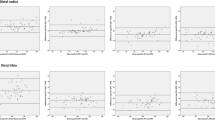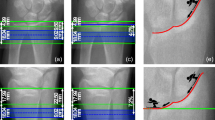Abstract
Summary
Precision errors need to be known when monitoring bone micro-architecture in children with HR-pQCT. Precision errors for trabecular bone micro-architecture ranged from 1 to 8% when using the standard evaluation at the radius and tibia. Precision errors for cortical bone micro-architecture ranged from 1 to 11% when using the advanced cortical evaluation.
Introduction
Our objective was to define HR-pQCT precision errors (CV%RMS) and least significant changes (LSCs) at the distal radius and tibia in children using the standard evaluation and the advanced cortical evaluation.
Methods
We scanned the distal radius (7% of ulnar length) and tibia (8% of tibia length) of 32 children (age range 8–13; mean age 11.3; SD 1.6 years) twice (1 week apart) using HR-pQCT (XtremeCT1). We calculated root-mean-squared coefficients of variation (CV%RMS) to define precision errors and LSC to identify differences required to detect change.
Results
Precision errors ranged between 1–8 and 1–5% for trabecular bone outcomes (obtained with standard evaluation) and between 1.5–11 and 0.5–6% for cortical bone outcomes (obtained with advanced cortical evaluation) at the distal radius and tibia, respectively. Related LSCs ranged between 3–21 and 3–14% for trabecular bone outcomes and between 4–30 and 2–16% for cortical bone outcomes at the distal radius and tibia, respectively.
Conclusions
HR-pQCT precision errors were between 1 and 8% (LSC 3–21%) for trabecular bone outcomes and 1 and 11% (LSC 2–30%) for cortical bone outcomes at the radius and tibia in children. Cortical bone outcomes obtained using the advanced cortical evaluation appeared to have lower precision errors than cortical outcomes derived using the standard evaluation. These findings, combined with better-defined cortical bone contours with advanced cortical evaluation, indicate that metrics from advanced cortical evaluation should be utilized when monitoring cortical bone properties in children.

Similar content being viewed by others
References
Kirmani S, Christen D, van Lenthe GH et al (2009) Bone structure at the distal radius during adolescent growth. J Bone Miner Res 24:1033–1042
Burrows M, Liu D, McKay H (2010) High-resolution peripheral QCT imaging of bone micro-structure in adolescents. Osteoporos Int 21:515–520
Burrows M, Liu D, Moore S, McKay H (2010) Bone microstructure at the distal tibia provides a strength advantage to males in late puberty: an HR-pQCT study. J Bone Miner Res 25:1423–1432
Burrows M, Liu D, Perdios A, Moore S, Mulpuri K, McKay H (2010) Assessing bone microstructure at the distal radius in children and adolescents using HR-pQCT: a methodological pilot study. J Clin Densitom 13:451–455
Liu D, Burrows M, Egeli D, McKay H (2010) Site specificity of bone architecture between the distal radius and distal tibia in children and adolescents: an HR-pQCT study. Calcif Tissue Int 87:314–323
Wang Q, Wang XF, Iuliano-Burns S, Ghasem-Zadeh A, Zebaze R, Seeman E (2010) Rapid growth produces transient cortical weakness: a risk factor for metaphyseal fractures during puberty. J Bone Miner Res 25:1521–1526
Ackerman KE, Nazem T, Chapko D, Russell M, Mendes N, Taylor AP, Bouxsein ML, Misra M (2011) Bone microarchitecture is impaired in adolescent amenorrheic athletes compared with eumenorrheic athletes and nonathletic controls. J Clin Endocrinol Metab 96:3123–3133
McKay H, Liu D, Egeli D, Boyd S, Burrows M (2011) Physical activity positively predicts bone architecture and bone strength in adolescent males and females. Acta Paediatr 100:97–101
Chevalley T, Bonjour JP, van Rietbergen B, Ferrari S, Rizzoli R (2011) Fractures during childhood and adolescence in healthy boys: relation with bone mass, microstructure, and strength. J Clin Endocrinol Metab 96:3134–3142
Bacchetta J, Boutroy S, Vilayphiou N, Ranchin B, Fouque-Aubert A, Basmaison O, Cochat P (2011) Bone assessment in children with chronic kidney disease: data from two new bone imaging techniques in a single-center pilot study. Pediatr Nephrol 26:587–595
Nishiyama KK, Macdonald HM, Moore SA, Fung T, Boyd SK, McKay HA (2012) Cortical porosity is higher in boys compared with girls at the distal radius and distal tibia during pubertal growth: an HR-pQCT study. J Bone Miner Res 27:273–282
Kim S, Macdonald HM, Nettlefold L, McKay HA (2013) A comparison of bone quality at the distal radius between Asian and white adolescents and young adults: an HR-pQCT study. J Bone Miner Res 28:2035–2042
Yu WS, Chan KY, Yu FW, Yeung HY, Ng BK, Lee KM, Lam TP, Cheng JC (2013) Abnormal bone quality versus low bone mineral density in adolescent idiopathic scoliosis: a case-control study with in vivo high-resolution peripheral quantitative computed tomography. Spine J 13:1493–1499
Hoy CL, Macdonald HM, McKay HA (2013) How does bone quality differ between healthy-weight and overweight adolescents and young adults? Clin Orthop Relat Res 471:1214–1225
Farr JN, Amin S, Melton LJ 3rd, Kirmani S, McCready LK, Atkinson EJ, Muller R, Khosla S (2014) Bone strength and structural deficits in children and adolescents with a distal forearm fracture resulting from mild trauma. J Bone Miner Res 29:590–599
Paggiosi MA, Eastell R, Walsh JS (2014) Precision of high-resolution peripheral quantitative computed tomography measurement variables: influence of gender, examination site, and age. Calcif Tissue Int 94:191–201
Chevalley T, Bonjour JP, van Rietbergen B, Ferrari S, Rizzoli R (2014) Tracking of environmental determinants of bone structure and strength development in healthy boys: an eight-year follow up study on the positive interaction between physical activity and protein intake from prepuberty to mid-late adolescence. J Bone Miner Res 29:2182–2192
Yu WS, Chan KY, Yu FW, Ng BK, Lee KM, Qin L, Lam TP, Cheng JC (2014) Bone structural and mechanical indices in adolescent idiopathic scoliosis evaluated by high-resolution peripheral quantitative computed tomography (HR-pQCT). Bone 61:109–115
Farr JN, Amin S, LeBrasseur NK, Atkinson EJ, Achenbach SJ, McCready LK, Joseph Melton L 3rd, Khosla S (2014) Body composition during childhood and adolescence: relations to bone strength and microstructure. J Clin Endocrinol Metab 99:4641–4648
Dimitri P, Jacques RM, Paggiosi M, King D, Walsh J, Taylor ZA, Frangi AF, Bishop N, Eastell R (2015) Leptin may play a role in bone microstructural alterations in obese children. J Clin Endocrinol Metab 100:594–602
Maatta M, Macdonald HM, Mulpuri K, McKay HA (2015) Deficits in distal radius bone strength, density and microstructure are associated with forearm fractures in girls: an HR-pQCT study. Osteoporos Int 26:1163–1174
Paupitz JA, Lima GL, Alvarenga JC, Oliveira RM, Bonfa E, Pereira RM (2016) Bone impairment assessed by HR-pQCT in juvenile-onset systemic lupus erythematosus. Osteoporos Int 27:1839–1848
Cheung TF, Cheuk KY, Yu FW et al (2016) Prevalence of vitamin D insufficiency among adolescents and its correlation with bone parameters using high-resolution peripheral quantitative computed tomography. Osteoporos Int 27:2477–2488
Gabel L, Macdonald HM, McKay HA (2017) Sex differences and growth-related adaptations in bone microarchitecture, geometry, density, and strength from childhood to early adulthood: a mixed longitudinal HR-pQCT study. J Bone Miner Res 32:250–263
Misra M, Ackerman KE, Bredella MA, Stanford FC, Faje AT, Nordberg A, Derrico NP, Bouxsein ML (2017) Racial differences in bone microarchitecture and estimated strength at the distal radius and distal tibia in older adolescent girls: a cross-sectional study. J Racial Ethn Health Disparities 4:587–598
Wang ZW, Lee WY, Lam TP, Yip BH, Yu FW, Yu WS, Zhu F, Ng BK, Qiu Y, Cheng JC (2017) Defining the bone morphometry, micro-architecture and volumetric density profile in osteopenic vs non-osteopenic adolescent idiopathic scoliosis. Eur Spine J 26:1586–1594
Fratzl-Zelman N, Roschger P, Misof BM, Pfeffer S, Glorieux FH, Klaushofer K, Rauch F (2009) Normative data on mineralization density distribution in iliac bone biopsies of children, adolescents and young adults. Bone 44:1043–1048
Glorieux FH, Travers R, Taylor A, Bowen JR, Rauch F, Norman M, Parfitt AM (2000) Normative data for iliac bone histomorphometry in growing children. Bone 26:103–109
Kontulainen SA, Kawalilak CE, Johnston JD, Bailey DA (2013) Prevention of osteoporosis and bone fragility: a pediatric concern. Am J Lifestyle Med 7:405–417
Baim S, Leonard MB, Bianchi ML, Hans DB, Kalkwarf HJ, Langman CB, Rauch F (2007) Official positions of the International Society for Clinical Densitometry and executive summary of the 2007 ISCD Pediatric Position Development Conference. J Clin Densitom 11:6–21
Kawalilak CE, Johnston JD, Olszynski WP, Leswick D, Kontulainen SA (2014) Comparison of short term in vivo precision of bone density and micro-architecture at the distal radius and tibia between postmenopausal women and young adults. J Clin Densitom 17:510–517
Bonaretti S, Majumdar S, Lang TF, Khosla S, Burghardt AJ (2017) The comparability of HR-pQCT bone measurements is improved by scanning anatomically standardized regions. Osteoporos Int 28:2115–2128
Kawalilak CE, Johnston JD, Olszynski WP, Kontulainen SA (2014) Characterizing micro-architectural changes at the distal radius and tibia in postmenopausal women using HR-pQCT. Osteoporos Int 25:2057–2066
Pialat JB, Burghardt AJ, Sode M, Link TM, Majumdar S (2012) Visual grading of motion induced image degradation in high resolution peripheral computed tomography: impact of image quality on measures of bone density and micro-architecture. Bone 50:111–118
Kawalilak CE, Johnston JD, Cooper DM, Olszynski WP, Kontulainen SA (2016) Role of endocortical contouring methods on precision of HR-pQCT-derived cortical micro-architecture in postmenopausal women and young adults. Osteoporos Int 27:789–796
Laib A, Hauselmann HJ, Ruegsegger P (1998) In vivo high resolution 3D-QCT of the human forearm. Technol Health Care 6:329–337
MacNeil JA, Boyd SK (2008) Improved reproducibility of high-resolution peripheral quantitative computed tomography for measurement of bone quality. Med Eng Phys 30:792–799
Burghardt AJ, Buie HR, Laib A, Majumdar S, Boyd SK (2010) Reproducibility of direct quantitative measures of cortical bone microarchitecture of the distal radius and tibia by HR-pQCT. Bone 47:519–528
Burghardt AJ, Kazakia GJ, Ramachandran S, Link TM, Majumdar S (2010) Age- and gender-related differences in the geometric properties and biomechanical significance of intracortical porosity in the distal radius and tibia. J Bone Miner Res 25:983–993
Glüer CC, Blake G, Lu Y, Blunt BA, Jergas M, Genant HK (1995) Accurate assessment of precision errors: how to measure the reproducibility of bone densitometry techniques. Osteoporos Int 5:262–270
Glüer CC (1999) Monitoring skeletal changes by radiological techniques. J Bone Miner Res 14:1952–1962
Engelke K, Adams JE, Armbrecht G et al (2008) Clinical use of quantitative computed tomography and peripheral quantitative computed tomography in the management of osteoporosis in adults: the 2007 ISCD Official Positions. J Clin Densitom 11:123–162
Bonnick SL, Johnston CC, Kleerekoper M, Lindsay R, Miller P, Sherwood L, Siris E (2001) Importance of precision in bone density measurements. J Clin Densitom 4:105–110
Kawalilak CE, Johnston JD, Olszynski WP, Kontulainen SA (2015) Least significant changes and monitoring time intervals for high-resoltuion pQCT-derived bone outcomes in postmenopausal women. J Musculoskelet Neuronal Interact 15:190–196
Swinford RR, Warden SJ (2010) Factors affecting short-term precision of musculoskeletal measures using peripheral quantitative computed tomography (pQCT). Osteoporos Int 21:1863–1870
Acknowledgements
We would like to thank all our participants for their altruism and volunteering for the study. CE Kawalilak acknowledges the Saskatchewan Health and Research Foundation (SHRF) and the Canadian Institute for Health Research (CIHR) for her post-doctoral fellowship funding. This work was supported in part by grants from CIHR Regional Partnership Program New Investigator Award (SK) and University of Saskatchewan CIHR Bridge funding.
Author information
Authors and Affiliations
Corresponding author
Ethics declarations
Parents provided consent to study participation and children provided their assent prior to the study. This study was approved by the University of Saskatchewan Biomedical Research Ethics Board.
Conflicts of interest
None.
Electronic supplementary material
Supplementary Table 1.
(DOCX 33 kb)
Supplementary Table 2.
(DOCX 31 kb)
Rights and permissions
About this article
Cite this article
Kawalilak, C.E., Bunyamin, A.T., Björkman, K.M. et al. Precision of bone density and micro-architectural properties at the distal radius and tibia in children: an HR-pQCT study. Osteoporos Int 28, 3189–3197 (2017). https://doi.org/10.1007/s00198-017-4185-y
Received:
Accepted:
Published:
Issue Date:
DOI: https://doi.org/10.1007/s00198-017-4185-y




